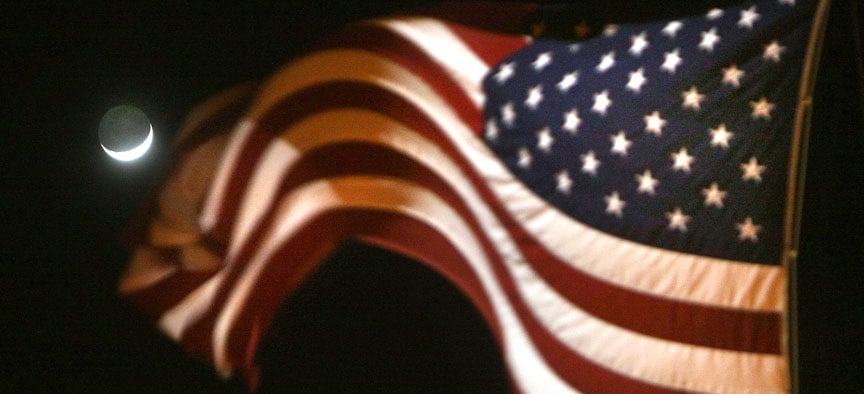[caption id="attachment_131726" align="aligncenter" width="900"]
Look how pretty. This will be the scene from your yard, apartment window or driving west along a freeway Tuesday evening about 45 minutes after sundown. Saturn and the Moon will be in conjunction about 3 degrees apart with Venus 6 degrees to the southeast of the crescent. Source: Stellarium[/caption]
I love easy and bright. While I often spend time seeking faint nebulae and wandering comets, there's nothing like just looking up and seeing a beautiful scene aglow in the night sky. No binoculars or telescope needed. That's exactly what will happen Tuesday November 2, when an attractive crescent Moon will join Saturn and Venus at dusk in the southwestern sky.
[caption id="attachment_102874" align="alignleft" width="409"]
The Supermoon of March 19, 2011 (right), compared to an average moon of December 20, 2010 (left). November's Supermoon will be 14% bigger and 30% brighter than a regular Full Moon. Credit: Marco Langbroek / Wikimedia Commons[/caption]
What a fine threesome they'll make: Venus the white-hot spark shining at magnitude –4.0; Saturn a mellow magnitude +0.5, some 20 times fainter and the Moon a fingernail crescent above them both. The Moon will be just two days past apogee, the furthest point in its orbit from Earth. Does it look a little smaller than the usual crescent? If you're a keen watcher of crescents, you just might notice the difference.
In less than two weeks, on November 14, the crescent will have waxed to full, swung around to the opposite end of its orbit, where it will be at perigee, its closest point to Earth. When a Full Moon occurs at perigee, we call it a
Supermoon
because it's closer and correspondingly bigger and brighter than a typical Full Moon.
For a variety of reasons, the November Supermoon will come exceptionally close to Earth, the closest one in 70 years as a matter of fact. The last time Earth and Moon embraced each other so tightly was January 26, 1948, the year baseball great Babe Ruth died. But I'm getting ahead of myself. We'll have much more on the Supermoon soon!
[caption id="attachment_131727" align="aligncenter" width="900"]
This photo shows the contrast between the bright, sunlit crescent and the ghostly earth-lit Moon. Several prominent craters are identified. Credit: Bob King[/caption]
Tuesday night you have the pleasure of an eye-catching crescent filled with darkly luminous
earthshine
, sunlight reflected off our jolly blue and white globe into space that reflects from the Moon and back to Earth. Being twice reflected, the returning light is feeble, giving the Moon a haunted look.
[caption id="attachment_131729" align="aligncenter" width="864"]
The phases of the Moon and Earth are complementary; when one's a crescent, the other's nearly full. Credit: Bob King, Source: Stellarium[/caption]
Crescent phase is when earthshine is brightest. Why? Phases of Earth and Moon are complementary — when we see a crescent, an astronaut on the Moon would look back to see a nearly Full Earth in the sky. As you've already guessed, a Full Earth reflects a great deal more light than a half or crescent. Be sure to point your binoculars at the earth-lit Moon; the contrast of dusky earthlight adjacent to the sunlit crescent gives the scene a striking 3D look.
And if your glass can magnify ten times or more, you'll get a sneak preview of several of the dark lunar seas or maria in the smoky light. Seas that will by and by ease into sunlight as the lunar terminator, the line separating day from night, rolls ever westward.
[caption id="attachment_131725" align="aligncenter" width="900"]
Through a small telescope, Venus appears three-quarters full in waning gibbous phase. Saturn's rings are still tipped wide open, and its brightest moon, Titan, should be easy to spot Tuesday night in a small telescope. Appearances are shown for Nov. 2. North is up and west to the right. Source: Stellarium[/caption]
Have a small telescope? This may be one of your last easy chances at seeing the planet Saturn before it's gobbled up by the western horizon. The ringed one has been sinking westward the past couple months and will soon be in conjunction with the Sun. I hate to see a good planet go, that's why I'm happy to share that Venus will be with us a long, long time. Watch for this most brilliant of planets to rise higher in the southwestern sky as we approach Christmas and then swing to the north through early winter before dropping out of the evening sky in March 2017.
Thank you Venus for lighting our path on the snowy nights that lie ahead!
*** If you'd like learn more about how to find the planets, check out my new book,
Night Sky with the Naked Eye
. It covers all the wonderful things you can see in the night sky without special equipment. The book publishes on Nov. 8, but you can pre-order it right now at these online stores. Just click an icon to go to the site of your choice - Amazon, Barnes & Noble or Indiebound. It's currently available at the first two outlets for a very nice discount:
 Universe Today
Universe Today
